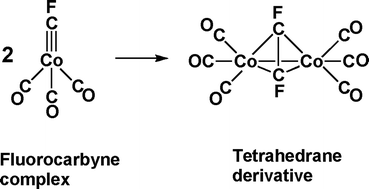Dimerization of a fluorocarbyne complex to a tetrahedrane derivative: Fluorocarbyne and difluoroacetylene cobalt carbonyl complexes†
Abstract
Recent work has resulted in the discovery of the

* Corresponding authors
a Institute of Chemical Physics, Beijing Institute of Technology, Beijing, P. R. China
b Center for Computational Quantum Chemistry, School of Chemistry and Environment, South China Normal University, Guangzhou, P. R. China
c Department of Chemistry and Center for Computational Chemistry, University of Georgia, Athens, Georgia, USA
Recent work has resulted in the discovery of the

 Please wait while we load your content...
Something went wrong. Try again?
Please wait while we load your content...
Something went wrong. Try again?
X. Gong, X. Zhang, Q. Li, Y. Xie, R. B. King and H. F. Schaefer III, Dalton Trans., 2010, 39, 5242 DOI: 10.1039/B924689D
To request permission to reproduce material from this article, please go to the Copyright Clearance Center request page.
If you are an author contributing to an RSC publication, you do not need to request permission provided correct acknowledgement is given.
If you are the author of this article, you do not need to request permission to reproduce figures and diagrams provided correct acknowledgement is given. If you want to reproduce the whole article in a third-party publication (excluding your thesis/dissertation for which permission is not required) please go to the Copyright Clearance Center request page.
Read more about how to correctly acknowledge RSC content.
 Fetching data from CrossRef.
Fetching data from CrossRef.
This may take some time to load.
Loading related content
